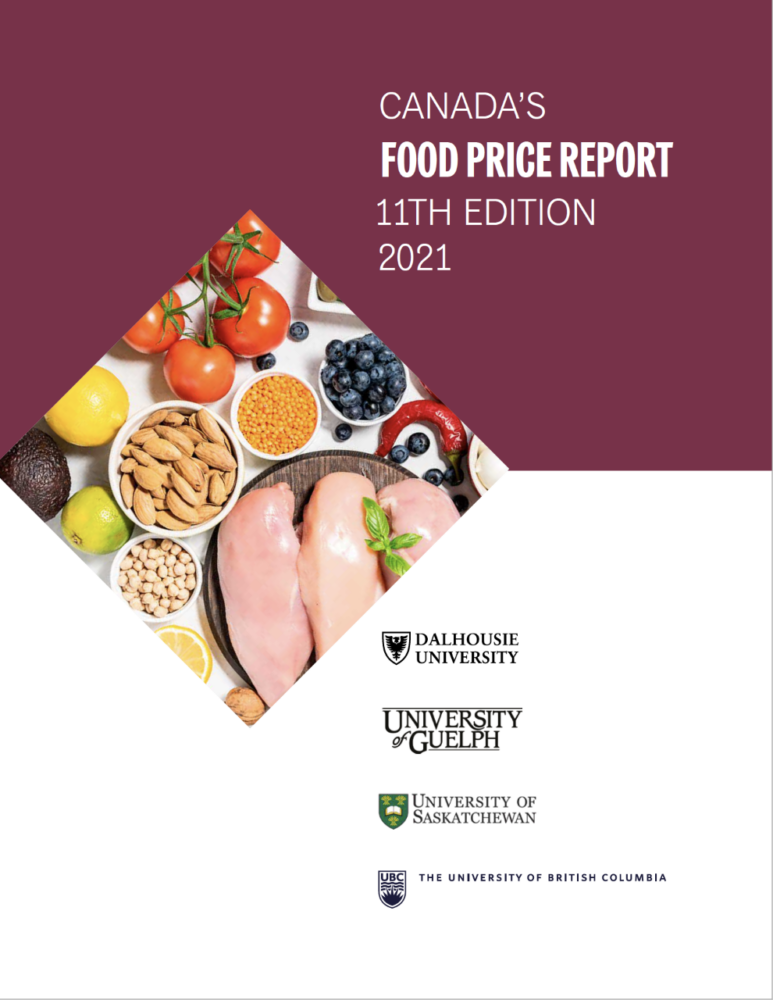 Meat and vegetables are behind the expected overall 3- to 5-per-cent increase in food prices in 2021, according to the annual Canada’s Food Price Report.
Meat and vegetables are behind the expected overall 3- to 5-per-cent increase in food prices in 2021, according to the annual Canada’s Food Price Report.
This year’s report forecasts meat and vegetables to jump by as much as 6.5 per cent. Bakery is predicted to increase by as much as 5.5 per cent.
Families can expect to add $695 to their overall food bill this coming year.
Released today, the 11th annual report provides a price forecast for eight food categories and is a joint project between the University of Guelph’s Arrell Food Institute (AFI) and Dalhousie University’s Agri-Food Analytics Lab, as well as the University of British Columbia and the University of Saskatchewan.
U of G Prof. Simon Somogyi, project co-lead and Arrell Chair in the Business of Food, said the overall food price increase of up to 5 per cent “is one of the higher predicted increases in the history of our report.”
He points to COVID-19-driven costs incurred by meat processing plants, such as the need for personal protective equipment (PPE) as one reason for rising prices. For vegetables, the price is driven by the value of the Canadian dollar, since so many of our vegetables are imported.
“We saw the supply chain having greater sanitization and PPE costs as well as other costs associated with distancing workers, all of which contributed to higher food prices,” he said. “Also, fluctuations in the Canadian dollar early on in the pandemic did not help.”
Bakery prices are determined mostly by the global wheat market, he added.
“Potential for wheat shortages in global markets means higher prices.”
Other key predictions in the report include price increases of 2 to 4 per cent for fruit, 1.5 to 3.5 per cent for seafood and 1 to 3 per cent for dairy, and an overall increase in restaurant prices of 3 to 5 per cent.

Prof. Sylvain Charlebois, project lead and director of the Agri-Food Analytics Lab at Dalhousie University, said these rising prices are enough to put a financial strain on many families.
“Families with less means will be significantly challenged in 2021, and many will be left behind,” said Charlebois. “Immunity to higher food prices requires more cooking, more discipline and more research. It’s as simple as that.”
Somogyi said the rising prices will make it more difficult for families to eat healthy.
“Health Canada wants us to eat more vegetables and that’s going to be harder. Hopefully when the Canadian growing season comes online in summer 2021, prices will soften and more families will have access,” he said. “When folks go to the grocery store, they should have a look in the frozen food aisle, particularly for peas, broccoli, carrots and corn. Frozen vegetables are snap frozen just after harvest, so their nutrients are locked in. They can be just as nutritious as fresh vegetables, but at a lower price.”
The COVID-19 pandemic led to border and facility closures, shifting consumer demand and unemployment, as well as modifications in production, manufacturing, distribution and retailing practices to enhance safety — all of which impacted food prices. An oil price war and the devaluation of the Canadian dollar were also significant factors.
Last year’s report predicted the average Canadian family would spend up to $12,667 on food in 2020. Based on the 2020 inflation rate to date, this figure is likely to be closer to $12,508, largely because consumers ate at restaurants less frequently.
“The COVID-19 pandemic will potentially have long-lasting effects on Canadians’ relationship to food,” said Alyssa Gerhardt, a PhD student in the Department of Sociology and Social Anthropology at Dalhousie who worked on the project. “We’ve seen more demand for online services in both food retail and food service, an increase in Canadians gardening and preparing meals at home, and renewed interest in local food supply chains.”
“While the impacts of the pandemic and the uncertainty that accompanies it will continue into 2021, Canadians can be confident in their food supply,” said Prof. Stuart Smyth, project co-lead and Agri-Food Innovation and Sustainability Enhancement Chair at the University of Saskatchewan.
“Canada has one of the safest food systems in the world that has, over the past 10 months, shown just how resilient it is when it comes to responding in an efficient and timely fashion to ensure that consumers are guaranteed a constant provision of safe, nutritious food products,”
Prof. James Vercammen, project co-lead and professor in the the Faculty of Land and Food Systems at the Sauder School of Business at UBC, said that except for some short-term hoarding of high-demand food products, food supply chains continue to function remarkably well.
“But consumers need to understand that Canada imports a sizable fraction of its fresh fruits and vegetables from the U.S., Mexico and other countries. The potential exists for significant disruptions in these imports if there is a second wave of the COVID-19 pandemic.”
Food price factors to watch for in 2021 include the continued impact of COVID-19, effects of climate change, growth in e-commerce and online services, continued loss of the food manufacturing sector, the national ban on some single-use plastics and the impact of the U.S. presidential election on food policy and the Canadian dollar.
The research team uses historical data sources, machine learning algorithms, and predictive analytics tools developed over many years to predict food prices in Canada. Other U of G members involved in the report were Prof. Erna van Duren, School of Hospitality, Food and Tourism Management; Paul Uys, director (external) of AFI; Prof. Jess Haines, Department of Family Relations and Applied Nutrition; Prof. Maria Corradini, Department of Food Science; and Prof. Graham Taylor and post-doc Ethan Jackson, School of Engineering and Vector Institute.
For more information, read the complete Canada’s Food Price Report 2021.
Contact:
Prof. Simon Somogyi
ssomogyi@uoguelph.ca